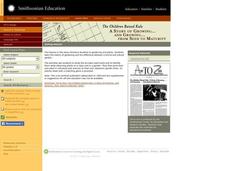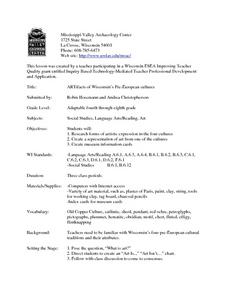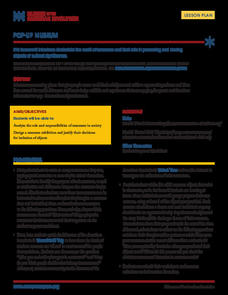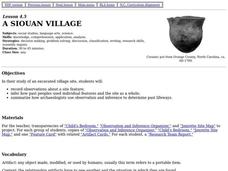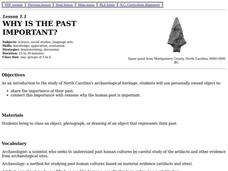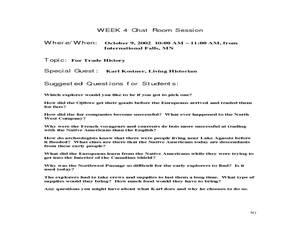Curated OER
Daily Life in Ancient Egypt
Students explain how artwork can inform about a culture and its traditions. They pretend to be archaeologists who have just opened a tomb. They interpret the past based on what they discover.
Curated OER
Inventions over Time
Sixth graders examine inventions, such as spear points and bows and arrows, and discuss their importance in human cultural development. They compare these early inventions with modern ones and determine the impact of science and...
Curated OER
Ancient Book Found in Ireland
Students discuss items archeologists search for during digs and read a news article about a 2200-year-old religious book found in Ireland. They examine the article for examples of the passive voice. They make lists of items for a time...
Curated OER
Baga Drum
Learners examine a Baga Drum in order to explore the history of the Baga people of West Africa. In this art history lesson, students recognize figures used in Baga Drum design that represent aspects of Baga culture. They also design and...
Curated OER
Stonehenge: Solving Ancient Mysteries
Students explore archeologists and anthropologists and the tools and methods they use to gather and interpret scientific evidence. They research current archaeological excavations and contact the scientists working at these digs.
Curated OER
Ancient Greece
Sixth graders examine the research that archaeologists have done on a Late Bronze Age shipwreck in order to work out the extent of trade in the Eastern Mediterranean during this period, with emphasis on the involvement of the Mycenaeans...
Curated OER
Artifacts of Wisconsin's Pre-european Cultures
Students research forms of artistic expression in four cultures. They create a representation of art from one of the cultures and create museum information cards. They develop a rubric to evaluate each others work.
Mississippi Department of Archives and History
Protesting Violence without Violence
The ultimate legacy of Emmett Till's violent death is its role in the non-violent roots of the Civil Rights Movement. A lesson compares contemporaneous articles with the lyrics of Bob Dylan's "The Death of Emmett Till" and prompts...
Museum of the American Revolution
Pop-Up Museum
Museums offer more than interesting exhibits—they are key to keeping history alive. An immersive activity uses a virtual field trip to show academics the importance of museums in preserving history. Young historians learn how museums are...
Curated OER
Make a Paper Mache Bowl
Students create a paper mache bowl. In this paper mache lesson, students use wallpaper paste, newspapers, and paint brushes to construct a paper mache bowl. Students decorate their bowl with unique designs.
Curated OER
A Siouan Village
Fourth graders examine the artifacts obtained from an excavated Siouan village site. They make inferences about the people who once lived there based on the artifacts and complete a Research Team Report.
Curated OER
Motel of Mysteries
Students determine that even though inferences are based on observations that does not mean they are always true or correct. They pull the topics and main ideas out of a piece of difficult text.
Curated OER
Inca's Untangles World
Students read a reprinted article from USA Today. In this metacognition lesson, students complete a worksheet about their thoughts while they are reading.
Curated OER
Archeological Thinking
Sixth graders review the differences between a historian and archaeolgists. At a recent archaeological dig site, they examine the artifacts and determine their usage. In groups, they are given a bag full of artifacts and write down what...
Curated OER
Looking Back to 1980
Students use clustering/mind mapping techniques to generate ideas, graphically represent inferences, organize their conclusions and write a report that presents conclusions the writer has reached, and facts substantiating those conclusions.
Curated OER
Why is the Past Important?
Fourth graders discuss the importance of North Carolina's archaeological heritage. They share with the class an object, photograph, or drawing of an object that represents their own or their family's past.
Curated OER
Tools of the Archeologist
Students review the job of an archeologist as a class. While viewing a PowerPoint presentation, they guess the use of the tool before the next slide is shown. They also discuss when the archeologist would use each of the twelve tools...
Curated OER
Dig This
Fifth graders explore the work of paleontologists and the life of dinosaurs and create a sculpture of the bones of a Stegosaurus. The sculpture was then buried and used by other classes for a dig.
Curated OER
Gridding a Site
Students make observations of effigy mounds and record them in a notebook. In groups, they must determine the scale of measurement and create their own grid to scale part of the Effigy Mounds National Monument. They also practice using...
Curated OER
Take Action, Save the Past
Eighth graders use their creative and critical thinking skills to find useful solutions to current and future problems concerning the destruction of archaeological sites and artifacts.
Curated OER
Old Mayan Mural
Students read a story called Scientists Discover Oldest Mayan Mural and answer vocabulary and comprehension questions about it. In this current events Mayan mural lesson plan, students respond to literature by answering questions,...
Curated OER
Vocabulary Charts
Seventh graders are introduced to the vocabulary associated with archeology. Using a dictionary, they practice finding the meaning of various words and create sentences. They also identify an appropriate use of the word and draw an...
Curated OER
Prehistoric Native American Lesson Plan: Make a Mississippian-style Gorget
Students create a Mississippian-style gorget using clay and a stylus to etch a design of a stylized spider.
Curated OER
Songs, Myths and Games
Fourth graders recognize that the Ojibwa lived in a serene environment which shows in their legends. In this songs, myths and games instructional activity, 4th graders recognize characteristics of the Ojibwas culture through the study of...





